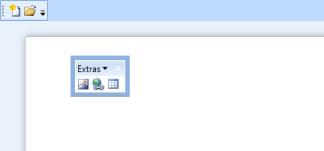ToolBarAdv State in WPF ToolBar (ToolBarAdv)
7 Nov 202418 minutes to read
ToolBarAdv provides different states such as Docking, Floating or Hidden. It can be change using the property ToolBarState of the ToolBarManager.
<syncfusion:ToolBarManager x:Name="toolBarManager" >
<syncfusion:ToolBarManager.TopToolBarTray>
<syncfusion:ToolBarTrayAdv >
<syncfusion:ToolBarAdv ToolBarName="Standard" Band="0">
<Button syncfusion:ToolBarAdv.Label="New Document"
syncfusion:ToolBarAdv.Icon="Images/New.png">
<<<<<<< HEAD
<Image Source="Images/New.png" Width="16" Height="16"/>
</Button>
<Button syncfusion:ToolBarAdv.Label="Open Document"
syncfusion:ToolBarAdv.Icon="Images/Open.png">
<Image Source="Images/Open.png" Width="16" Height="16"/>
=======
<Image Source="Images/NewDocumentHS.png" Width="16" Height="16"/>
</Button>
<Button syncfusion:ToolBarAdv.Label="Open Document"
syncfusion:ToolBarAdv.Icon="Images/Open.png">
<Image Source="Images/OpenDocument.png" Width="16" Height="16"/>
>>>>>>> bdfa52e6e6a5976c1080fd3d27faf929b36aca12
</Button>
<syncfusion:ToolBarAdv Band="1" ToolBarName="Extras"
syncfusion:ToolBarManager.ToolBarState="Floating"
FloatingBarLocation="500,300">
<Button syncfusion:ToolBarAdv.Label="Save Document"
syncfusion:ToolBarAdv.Icon="Images/Save.png">
<Image Source="Images/SaveDocument.png" Width="16" Height="16"/>
</Button>
<Button syncfusion:ToolBarAdv.Label="Insert Table"
syncfusion:ToolBarAdv.Icon="Images/Insert.png">
<Image Source="Images/InsertTable.png" Width="16" Height="16"/>
</Button>
</syncfusion:ToolBarAdv>
</syncfusion:ToolBarAdv>
</syncfusion:ToolBarTrayAdv>
</syncfusion:ToolBarManager.TopToolBarTray>
</syncfusion:ToolBarManager>ToolBarManager toolBarManager = new ToolBarManager();
//Initialize ToolBarTrayAdv
ToolBarTrayAdv toolBarTray = new ToolBarTrayAdv();
<<<<<<< HEAD
=======
// Initialize toolbar1 and subscribe to ToolBarStateChanged event
>>>>>>> bdfa52e6e6a5976c1080fd3d27faf929b36aca12
ToolBarAdv toolbar1 = new ToolBarAdv();
// Add a button to the toolbar1
toolbar1.Items.Add(new Button
{
Content = new Image
{
Source = new BitmapImage(new Uri("Images/Open.png")),
Stretch = Stretch.Uniform
},
Height = 40,
Width = 40,
ToolTip = "Open Folder",
Margin = new Thickness(5, 0, 5, 0)
});
// Add toolbar1 to the ToolBarTrayAdv
toolBarTray.ToolBars.Add(toolbar1);
// Set Floating location for the floating toolbar
toolbar1.FloatingBarLocation = new Point(500, 300);
// Set the floating toolbar state to floating
ToolBarManager.SetToolBarState(toolbar1, ToolBarState.Floating);
// Add buttons to the floating toolbar
toolbar1.Items.Add(new Button
{
Content = new Image
{
Source = new BitmapImage(new Uri("Images/Save.png")),
Stretch = Stretch.Uniform
},
Height = 40,
Width = 40,
ToolTip = "Save",
Margin = new Thickness(5, 0, 5, 0)
});
// Set the ToolBarTrayAdv as the top tray for the ToolBarManager
toolBarManager.TopToolBarTray = toolBarTray;
// Set the ToolBarManager as the main content
this.Content = toolBarManager;
ToolBarAdv can be floated only when it is hosted in ToolBarManager.
Specifying location for floating ToolBarAdv.
The location of the floating ToolBarAdv can be changed using the FloatingBarLocation property. The following code illustrates this
<<<<<<< HEAD
<syncfusion:ToolBarAdv FloatingBarLocation="50,50"/>
=======
<syncfusion:ToolBarAdv FloatingBarLocation="50,50"/>
>>>>>>> bdfa52e6e6a5976c1080fd3d27faf929b36aca12ToolBarAdv toolBar = new ToolBarAdv();
toolBar.FloatingBarLocation = new Point(50, 50);Restrict Docking of ToolBarAdv for a specific position
By default, the ToolBarAdv can be docked to any position. To restrict docking of ToolBarAdv to particular position, the following properties can be used. Each will restrict docking at corresponding positions in ToolBarManager.
- CanDockAtLeft—restricts docking at the left.
- CanDockAtTop—restricts docking at the top.
- CanDockAtRight—restricts docking at the right.
- CanDockAtBottom—restricts docking at the bottom.
Following code restricts docking at the top:
<<<<<<< HEAD
<syncfusion:ToolBarManager CanDockAtTop="False"/>
=======
<syncfusion:ToolBarManager CanDockAtTop="False"/>ToolBarManager toolBarManager = new ToolBarManager();
toolBarManager.CanDockAtTop = false;ToolBarStateChanged event
The ToolBarStateChanged event is triggered when the state of a ToolBarAdv changes, such as when it is hidden, floated, or docked. This event passes an instance of ToolBarStateChangedEventArgs, which contains information about the state change, including the old state and the new state of the toolbar.
NewState: Gets the current state of the ToolBarAdv control.
OldState: Gets the previous state of the ToolBarAdv control.
<syncfusion:ToolBarManager x:Name="toolBarManager" >
<syncfusion:ToolBarManager.TopToolBarTray>
<syncfusion:ToolBarTrayAdv >
<syncfusion:ToolBarAdv ToolBarStateChanged="Toolbar1_ToolBarStateChanged" ToolBarName="Standard" Band="0">
<Button syncfusion:ToolBarAdv.Label="Open Document"
syncfusion:ToolBarAdv.Icon="Images/Open.png">
<Image Source="Images/Open.png" Width="16" Height="16"/>
</Button>
<syncfusion:ToolBarAdv Band="1" ToolBarName="Extras">
<Button syncfusion:ToolBarAdv.Label="Save Document"
syncfusion:ToolBarAdv.Icon="Images/Save.png">
<Image Source="Images/Save.png" Width="16" Height="16"/>
</Button>
</syncfusion:ToolBarAdv>
</syncfusion:ToolBarAdv>
</syncfusion:ToolBarTrayAdv>
</syncfusion:ToolBarManager.TopToolBarTray>
</syncfusion:ToolBarManager>
>>>>>>> bdfa52e6e6a5976c1080fd3d27faf929b36aca12<<<<<<< HEAD
ToolBarManager toolBarManager = new ToolBarManager();
toolBarManager.CanDockAtTop = false;ToolBarStateChanged event
The ToolBarStateChanged event is triggered when the state of a ToolBarAdv changes, such as when it is hidden, floated, or docked. This event passes an instance of ToolBarStateChangedEventArgs, which contains information about the state change, including the old state and the new state of the toolbar.
NewState: Gets the current state of the ToolBarAdv control.
OldState: Gets the previous state of the ToolBarAdv control.
<syncfusion:ToolBarManager x:Name="toolBarManager" >
<syncfusion:ToolBarManager.TopToolBarTray>
<syncfusion:ToolBarTrayAdv >
<syncfusion:ToolBarAdv ToolBarStateChanged="Toolbar1_ToolBarStateChanged" ToolBarName="Standard" Band="0">
<Button syncfusion:ToolBarAdv.Label="Open Document"
syncfusion:ToolBarAdv.Icon="Images/Open.png">
<Image Source="Images/Open.png" Width="16" Height="16"/>
</Button>
<syncfusion:ToolBarAdv Band="1" ToolBarName="Extras">
<Button syncfusion:ToolBarAdv.Label="Save Document"
syncfusion:ToolBarAdv.Icon="Images/Save.png">
<Image Source="Images/Save.png" Width="16" Height="16"/>
</Button>
</syncfusion:ToolBarAdv>
</syncfusion:ToolBarAdv>
</syncfusion:ToolBarTrayAdv>
</syncfusion:ToolBarManager.TopToolBarTray>
</syncfusion:ToolBarManager>=======
>>>>>>> bdfa52e6e6a5976c1080fd3d27faf929b36aca12
ToolBarManager toolBarManager = new ToolBarManager();
ToolBarTrayAdv toolBarTray = new ToolBarTrayAdv();
ToolBarAdv toolbar1 = new ToolBarAdv();
// Subscribe to the ToolBarStateChanged event for toolbar1
toolbar1.ToolBarStateChanged += Toolbar1_ToolBarStateChanged;
toolbar1.Items.Add(new Button
{
Content = new Image
{
Source = new BitmapImage(new Uri("Images\\Open.png")),
Stretch = Stretch.Uniform
},
Height = 40,
Width = 40,
ToolTip = "Open Folder",
Margin = new Thickness(5, 0, 5, 0)
});
ToolBarAdv toolbar2 = new ToolBarAdv();
toolbar2.Items.Add(new Button
{
Content = new Image
{
Source = new BitmapImage(new Uri("Images\\Save.png")),
Stretch = Stretch.Uniform
},
Height = 40,
Width = 40,
ToolTip = "Save",
Margin = new Thickness(5, 0, 5, 0)
});
// Add ToolBars to the ToolBarTrayAdv
toolBarTray.ToolBars.Add(toolbar1);
toolBarTray.ToolBars.Add(toolbar2);
// Set the ToolBarTrayAdv as the top tray for the ToolBarManager
toolBarManager.TopToolBarTray = toolBarTray;
this.Content = toolBarManager;
private void Toolbar1_ToolBarStateChanged(object sender, ToolBarStateChangedEventArgs e)
{
// Access the new and old values
object oldValue = e.OldState;
object newValue = e.NewState;
}